Order Chiroptera | Scientific name Acerodon jubatus | |
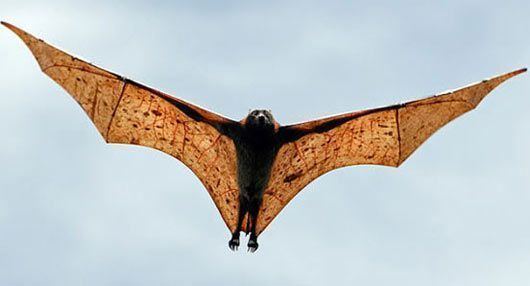 | ||
Similar Acerodon, Bat, Megabat, Flying foxes, Large flying fox Species A. jubatus | ||
Philippine giant golden crowned flying fox
The giant golden-crowned flying fox (Acerodon jubatus), also known as the golden-capped fruit bat, is a rare megabat and one of the largest bats in the world. The species is endangered and is currently facing the possibility of extinction because of poaching and forest destruction. It is endemic to forests in the Philippines. The bat can reach up to 1.2 kg (2.6 lb) in weight and 1.7 m (5.6 ft) in wingspan. Like other megabats, this species is non-aggressive towards humans and is frugivorous. Even though they are not aggressive, handling the bat without proper training and vaccination is dangerous, as some can carry deadly diseases.
Contents
- Philippine giant golden crowned flying fox
- Giant bat captured what is it
- Description
- Range
- Habitat
- Behavior
- Diet
- Reproduction
- Colonies
- Ecology
- HuntingPoaching
- Conservation Efforts
- Viruses
- References
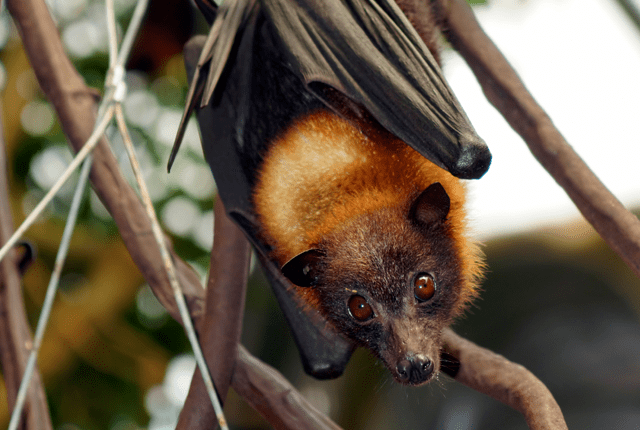
Giant bat captured what is it
Description
The giant golden-crowned flying fox gets its species name from the golden fur around the head, in sharp contrast to the black body. Like all other fruit bats, they have no tail. They are among the largest bats, with a wingspan of 1.5–1.7 metres (4 ft 11 in–5 ft 7 in) and weighing 0.7–1.2 kilograms (1.5–2.6 lb). The only other bats with similar dimensions are a few species of Pteropus.
Range
Recent surveys have found A. jubatus roosting with P. vampyrus on the islands of Bohol, Boracay, Cebu, Leyte, Luzon, Mindanao, Mindoro, Negros and Polillo.
Habitat
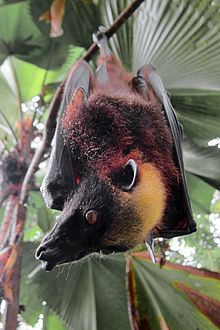
The giant golden-crowned flying fox is confined to the forests of the Philippines, where it occurs mostly at elevations from sea level to 1,100 m (3,600 ft). It prefers uninhabited areas. A 2005 study found none in inhabited areas. The same study also revealed that these bats use river corridors called riparian zones more than originally thought, because the fig trees located near rivers are the bats' main source of food. They like to be close to agricultural fields, but only in undisturbed forest areas.
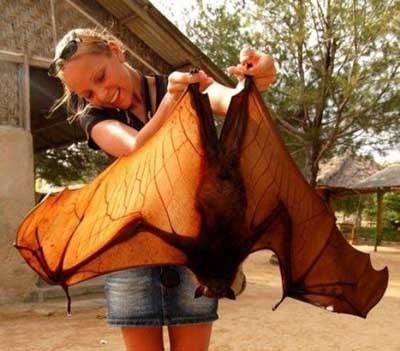
In another study it was shown that this species is a forest obligate species, staying in the forest a majority of the time. Since this is a forest obligate species, conservation will require the preservation of forest areas. Human encroachment on the bat's habitat in forest and lowland areas is a major factor in the species endangered conservation status. Indeed, since 1900 the total forest coverage of the Philippines has been reduced from 70% to 20%. Below 10% of the original lowland forest cover now remains. One of the islands A. Jubatus is found on, Negros, retains only 4% of its original forest coverage.
Behavior
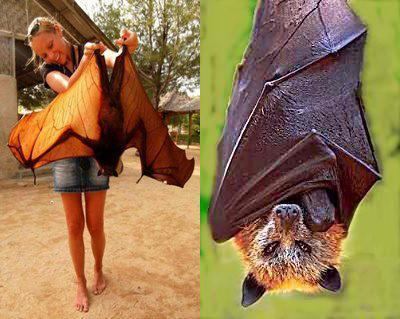
The giant golden-crowned flying fox is primarily nocturnal, and can travel at least 40 kilometres (25 mi) in one night searching for food. This bat is a pollinator and seed disperser for many fruit trees in the Philippines. It uses water for grooming.
Diet
The primary diet of Acerodon jubatus is composed of figs and leaves from the lowland forests of the Philippine Islands. This was determined by fecal analysis on the bats near Subic Bay, West Central Luzon. Seeds were present in both species of Acerodon jubatus and Pteropus Vampyrus Lanesis. Both species generally select separate trees or distinct areas within a shared canopy to roost. Droppings were then collected separately, screened, and examined. The seeds of the droppings were examined and classified using field guides and lexicons. Dietary items were deemed important if they were consistently eaten, ubiquitous across the population, and of clear nutritional value.
The results support that the primary food group is composed of fig species. F. subcordata, known by the local name payapa, was found in the stool of the bats. Unidentified leave compositions were also found to be in the droppings of Acerodon jubatus. Figs are a dietary stable and also a keystone resource for the Acerodon jubatus. Whether this food group is important in their conservation is up for debate. There is a lack of consensus on whether items deemed important are actually prioritized or found as an alternative food for these bats.
Multiple types of figs can also contribute to different nutrients for the Acerodon jubatus. Frugivorous bats usually do not consume foods rich in protein. The overconsumption of fruits, paired with leaves may contribute to an adequate amount of protein in their diet. Figs are superior sources of calcium, which may also aid in their growth to adults.
Acerodon jubatus probably flies long distances to feed because of deforestation and habitat loss. On Maripipi, bats were observed commuting at least 12 km to foraging sites on Biliran. Foraging distances could be as far as 20 or 30 km away. This means that the bats spend time outside of protected areas, increasing their chance of being killed.
The Acerodon jubatus also aids in the regeneration of the forest. By eating the fruits of the lowlands, they disperse seeds across the islands through their droppings. This maintains and increases plant diversity across the Philippines. Bats may also be in the few species that act as pollinators and seed dispersers of these plants. By hunting these bats, there is a significant threat to their populations, as well as environments.
Reproduction
Little is known about their reproduction. They appear to have two breeding seasons, but females only become pregnant during one of them. They typically give birth to only one pup. Females reach sexual maturity at two years.
Colonies
When fruit bats were abundant in the Philippines, the giant golden-crowned flying fox and the large flying fox (Pteropus vampyrus) would make colonies, reportedly numbering over 150,000 individuals. It is this roosting behavior that made them so easy to hunt, but also helps them keep warm and avoid natural predators.
Ecology
While the roosting sites of A. jubatus can be far from human presence, roosting sites have been discovered close to roads and adjacent to sub-suburban locations. This proximity is concerning, probing a Food and Agricultural Organization of the United Nations investigation as to how the infection began. While foraging for food, A. jubatus would easily spread diseases to livestock via saliva contamination of feeding grains and seeds, potentially spreading a harmful virus family called Filoviridae. Such ecological impact is relevant considering their known proximity with other species of bat, leading to proliferation of aforementioned viruses among the mammalian community, and the ecosystem at large. Varieties of bat species, including A. jubatus, are also proficient pollinators and seed dispensers, leading to a greater ecological impact, furthering biodiversity of fruit trees and otherwise endemic fauna.
Hunting/Poaching
The giant golden-crown flying fox is one of the many species that is considered endangered. One of the biggest contributions to the endangerment of the giant golden-crowned flying fox is due to hunting. This is said to be true especially in Southeast Asia, where half of the world’s flying fox species are located. Southeast Asia ultimately faces a widespread trend in fruit bat hunting, the world’s highest amount of natural habitat loss along with other factors that endanger the lives of the giant golden-crown flying fox. The hunt for this species is largely due to the demand for their meat and pelts. In addition to being hunted for their meat and pelts, the golden flying fox has also been targeted as a pest for the destruction of fruit crops.
Conservation Efforts
The giant golden-crowned flying fox is threatened by deforestation and has completely disappeared from many islands in the Philippines, such as Panay and most of Cebu. The extinct Panay populations were once considered a separate species, the Panay giant fruit bat (Acerodon lucifer), but is now included under Acerodon jubatus. Due to their size, the species is easily hunted. The species is not only hunted because of their size, but also because of the availability of licenses; although the species is endangered, they are still able to be hunted for sport and consumption when spotted outside of their roosts. One obvious way to facilitate conservation would be to lower the number of, if not get rid of entirely, the number of hunting licenses allowing the hunting of Acerodon Jubatus outside of roosts.
Due to little access to data and the incapability of determining the exact number of living bats, it is difficult to manage and conserve the species, but since the number of living is declining, conservation attempts are underway. The local government of Maitum, Sarangani in the Philippines has organized a campaign to save the species from extinction. The Subic Bay region of the Philippines plays host to a lot of the research on this species. Subic Bay is a 14,000-acre (57 km2) protection area that is managed by individuals who want to preserve the species.
Agencies promoting the conservation of this species include Bat Conservation International, the Wildlife Conservation Society, the World Wildlife fund, Lubee Foundation and others. They provide research funding and education worldwide as well as locally. In India they have started a research center in Hyderabad. Education focused on conservation would help protect species, such as Acerodon jubatus, get more attention and resources.
Captive breeding is one of the more reasonable and realistic ways to conserve the species. Captive breeding has been successful in many non-endangered species of bat, and the IUCN states that there is currently a captive breeding program underway for the species. If captive breeding is successful and the forests in which they occupy are still unsustainable, the bats will have to be relocated and introduced to a new area similar to the one they inhabit now. This is an incentive to limit the number of trees being cut down, allowing the forests to flourish for the species to be reintroduced.
Viruses
Serological tests conducted on flying-foxes, in conjunction with the molecular findings in insectivorous bats, found that ebolavirus infection is taxonomically widespread in Philippine bats. The fieldwork was conducted on the Philippine island Luzon in two different locations. The first location was the Bulacan Province and the second location Subic Bay Freeport Zone.
Since 2005, research has been expanding to obtain more information about the roles bats play in the maintenance, transmission, and evolution of filoviruses. When a variety of bat species proved to be reservoirs for filoviruses, the Philippine government and the Food and Agriculture Organization of the United Nations began to study Philippine bats to see if they could also be possible virus hosts.
In order to examine the theory that bats were carriers of the viruses in question, biological specimens were obtained from bats through non-lethal and minimally invasive methods, overseen by both a veterinarian and a seasoned wildlife biologist. The findings revealed that bats could indeed contract the virus, facilitate its replication, and ultimately survive the infection.
When screened, the A. jubatus was found to be serologic positive This finding in the bat bring forth potential risks. While searching for food, virus carrying Golden-crowned flying foxes can increase viral load under the feed tree/trees, which lengthens the exposure risk period and potentially facilitates an infectious dose of virus.
These findings could suggest that ebolavirus is circulating through specific bat populations. Efforts to identify further evidence for viruses infested bats in the Philippines are still underway.
